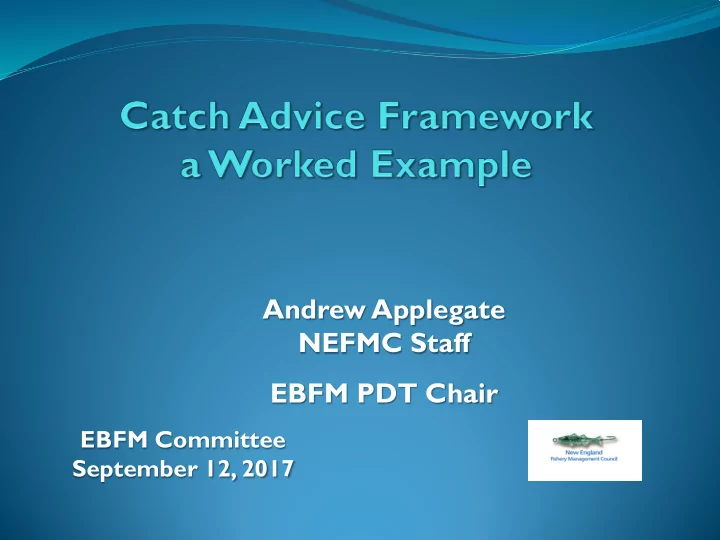

Andrew Applegate NEFMC Staff EBFM PDT Chair EBFM Committee September 12, 2017
NOAA Fisheries Definition EBFM Strategic Policy A systematic approach In a geographically specified area That ensures resilience and sustainability of the ecosystem Recognizes the physical, biological, economic, and social interactions Among the affected components of the ecosystem, including humans 2
EBFM Steps 1. Specify spatial management units 2. Define stock complexes 3. Establish specific management objectives and exploitation reference points. 4. Establish biomass thresholds (floors) 5. Devise an ecosystem-based harvest control rule 6. Simulate the performance of EBMP 7. Identify and reconcile tradeoffs. 3
EPU identification 4
Scope – area to be included Georges Bank EPU? 5
EBFM Framework 6
Productivity 7
Scope – species/stocks Georges Bank EPU 8
Functional groups 9
NEFMC Managed Species 10
Recent Fishing Mortality 11
Status Quo Target Exploitation 12
Georges Bank Landings 13
Georges Bank catch (mt) by Feeding guild: Commercial landings and discards, herring landings, Recreational (A+B1) 14
Georges Bank catch (mt) proportion by Feeding guild: 15
Western Gulf of Maine catch (mt) by Feeding guild: Commercial landings and discards, herring landings, Recreational (A+B1) 16
T esting management procedures 17
Draft Operational Framework Operating (ecosystem simulation) models Hydra – 10 species length-structured model with trophic interactions Ecosym/Ecopath (EwE) – mass-balance energy flow Atlantis – end-to-end with physical and biological processes Operational Framework Operating models used to evaluate management strategies Require goals and objectives to evaluate effectiveness Management Strategy Evaluation process Assessments to provide tactical advice Functional groups and EPU catch cap Ecosystem overfishing definition Overfished/depleted definitions for individual species 18
Harvest Control Rules 19
Worked examples of potential HCRs 1. Threshold exploitation (no ramp down) at Ex=0.15, 0.2, 0.25, 0.3 and Floor=0.2 of unfished biomass applied at the species complex level 2. Threshold exploitation (no ramp down) at Ex= 0.15, 0.2, 0.25, 0.3 and Floor=0.2 of unfished biomass applied at the individual species level 3. Threshold exploitation (no ramp down) at Ex= 0.15, 0.2, 0.25, 0.3 and Floor=0.2 of unfished biomass for each species except winter skate and dogfish (Floor=0.3 of unfished biomass) applied at the individual species level 4. Ramp-down exploitation using 'steps' at Ex=0.15, 0.2, 0.25, 0.3 and Starting at B/Bo = 0.4 applied at the species complex level 5. Ramp-down exploitation using 'steps' at Ex=0.15, 0.2, 0.25, 0.3 and Starting at B/Bo = 0.4 applied at the individual species level 6. Ramp-down exploitation using 'steps' at Ex=0.15, 0.2, 0.25, 0.3 and Starting at B/Bo = 0.5 applied at the individual species level for winter skate and dogfish 20
Worked examples of potential HCRs 1. Threshold exploitation (no ramp down) at Ex=0.15, 0.2, 0.25, 0.3 and Floor=0.2 of unfished biomass applied at the species complex level 2. Threshold exploitation (no ramp down) at Ex= 0.15, 0.2, 0.25, 0.3 and Floor=0.2 of unfished biomass applied at the individual species level 3. Threshold exploitation (no ramp down) at Ex= 0.15, 0.2, 0.25, 0.3 and Floor=0.2 of unfished biomass for each species except winter skate and dogfish (Floor=0.3 of unfished biomass) applied at the individual species level 4. Ramp-down exploitation using 'steps' at Ex=0.15, 0.2, 0.25, 0.3 and Starting at B/Bo = 0.4 applied at the species complex level 5. Ramp-down exploitation using 'steps' at Ex=0.15, 0.2, 0.25, 0.3 and Starting at B/Bo = 0.4 applied at the individual species level 6. Ramp-down exploitation using 'steps' at Ex=0.15, 0.2, 0.25, 0.3 and Starting at B/Bo = 0.5 applied at the individual species level for winter skate and dogfish 21
Scenario 1 Fixed exploitation Catch, biomass, and proportion overfished Fixed exploitation for all biomass levels 22
Scenario 1 Fixed exploitation 23
Scenario 4 Ramp applied to depleted guild Exploitation reduced for guilds Threshold: Guild biomass < 40% of unexploited state Floor, no landings: Guild biomass < 20% of unexploited state 24
Scenario 4 Ramp applied to depleted guild 25
Scenario 5 Ramp applied to depleted species Exploitation reduced for species Threshold: Species biomass < 40% of unexploited state Floor, no landings: Species biomass < 20% of unexploited state 26
Scenario 5 Ramp applied to depleted species 27
Catch biomass comparisons 28
Catch biomass comparisons 29
Application to managed species Species complex exploitation from simulation and tradeoff analyses Actual biomass determined from expanded survey data or multispecies assessment results Apply exploitation rate to above; group target catches by stock complex Aggregate amount is the ecosystem catch cap 30
Identifying Depleted Species Smooth research vessel survey estimates using Kalman filter Species classified as depleted when below 20% percentile
Other broad scale models Production Potential Upper Trophic Levels Benthivores Planktivores Deposit-Feeding Benthos Mesozooplankton Suspension-Feeding Benthos Microzooplankton Nanoflagellates Nano-Picoplankton Microplankton Bacteria
Back to the Real World: Fishery Production Potential by Functional Group Median Production Potential for Bivalves ~ 20kt (Live Weight) Median Production Potential all others ~ 220kt (Live Weight) [~160kt for currently Exploited species] Exploitation Rate= 0.2 for each functional group Production Potential includes all size classes and species within functional Groups
Performance metrics Punt et al. 2016 34
Performance metrics 35
Questions Science, models, and operational framework Is the operational framework and document clear? What critical elements are missing? Is the approach of establishing an EPU catch cap and allocations amongst functional groups of species an acceptable approach? What do you want the EBFM PDT to do next? 36
Questions Science, models, and operational framework Are the data and models sufficient to test and validate real world management approaches that could be implemented as regulations? What type of development or parameterization (tesing, peer review, etc) needed before developing a Management Strategy Evaluation (MSE) and engaging fishermen and the public? 37
Recommend
More recommend